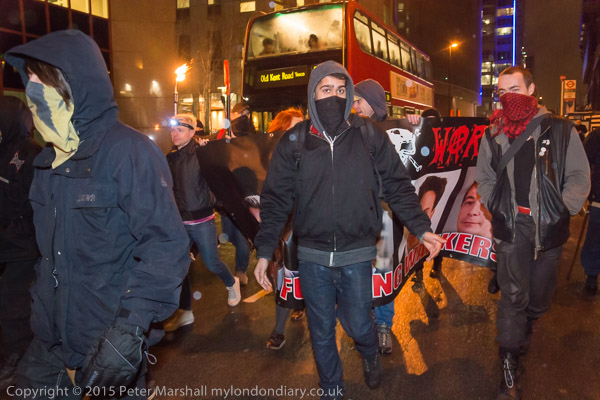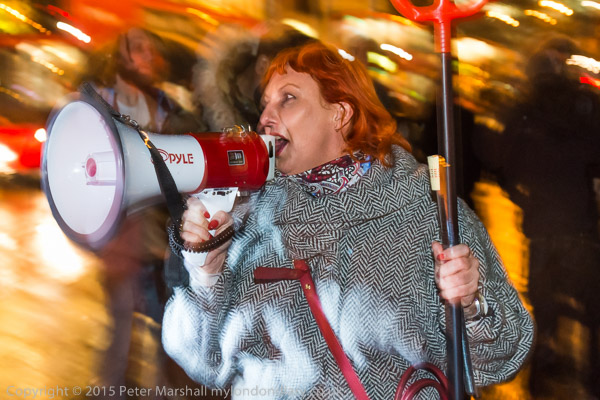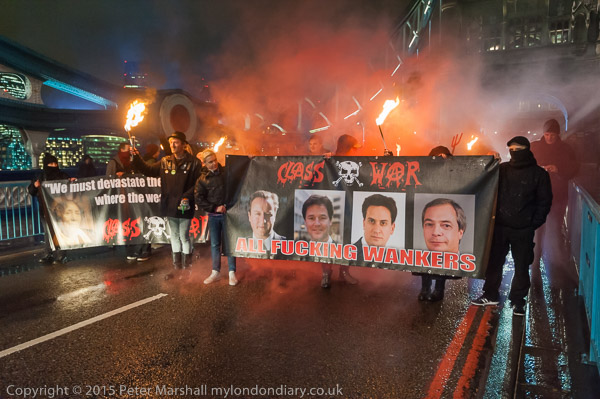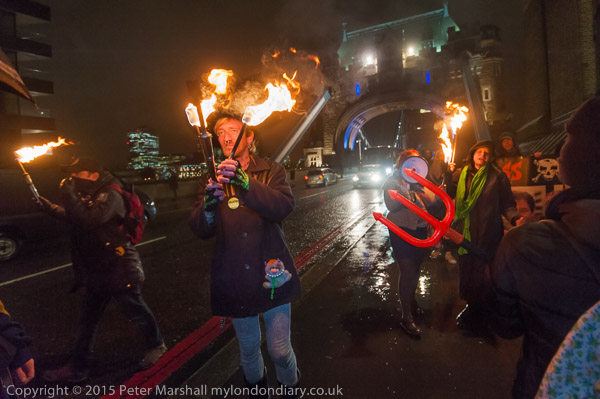
I think the image above captures something of the atmosphere of the march by Class War from ‘Poor Doors’ at ‘One Commercial St’ in Aldgate to the building site at ‘One Tower Bridge’, which as its name suggests is next to London’s trademark structure. It was an interesting event in several ways, and you can read more about it and see more pictures at Poor Doors to Rich Gardens on My London Diary.
The Exif data also makes interesting reading, at least for photographers, and here is a summary, copied with minor editing from viewing a larger copy of the image in FastPictureViewer Pro:
1/60s, f/4.5, ISO 3,200, -2.3Ev
Mode: A, Meter: Matrix, Flash, Auto WB
Focal: 18mm, 19/02/2015 18:46:20, Adobe RGB (1998)
15.4MP (4,800×3,200) NIKON D800E, 18.0-105.0 mm f/3.5-5.6, (C)2015,Peter Marshall
You can see that I was working in aperture priority mode, which surprises me slightly, as more often at night with moving subjects like this I use shutter priority, setting a shutter speed that will let me control the blur from ambient light, or more often still, manual, so I can chose both aperture and shutter.
The DX lens at 18mm has a maximum aperture of f3.5, so I had chosen to stop down by almost a stop, probably to get a little more depth of field. My focus was on the central figure, perhaps around 2.5 metres away, which would render anything from around 1.5 to 8m sharp at f4.5, while at f3.5 this would only have been from 1.7 to around 5.5m. Or perhaps I just felt that most lenses do get noticeably better if stopped down one stop (or usually better still two.)

With the camera on A setting (aperture priority) the camera selects the shutter speed, and it seems to do so on the basis of the ISO and the +/- Ev setting when I test. So ISO3200 and -2.3EV should I think mean it was actually using ISO 640, but the actual results are very different from those at that setting. But I give up trying to work these things out, just set things up and alter the exposure compensation until things seem to work. At night you always need a stop or two compensation or the camera will make it look like daylight.
Of course using flash I could have stopped down more. The SB800 I was using is a reasonably powerful unit, and had I left the camera on P, Nikon would have had me using it at a rather ridiculous f10, and the picture would have been a dismal failure with little or nothing visible behind the front trio.
It’s also a picture that needed considerable post-processing. The figure at left was rather close to the flash and needed rather a lot of burning in. The other two close figures also needed some, and parts of the subject further away needed to little brightening. Almost all flash images need some help in this way to get closer to how the scene actually appeared.
Another problem in using any light source at night is colour temperature. Flash is daylight balanced, and the ambient light seldom if ever is. In some pictures the difference isn’t important, but in others it becomes very noticeable. Occasionally it’s an interesting effect, but more often a distraction – and one that can be overcome with a little post-processing.
Flash also produces an unnatural effect in this image with a number of translucent white spots of varied sizes – for example between the skull and the W on the banner at the right of the picture. These are reflections of the flash from out of focus rain drops. It isn’t really something that was a part of the scene, but an artifact of the way that the image was produced, and although the WPP or Reuters might not agree, I’d have no compunction about removing any of them if I felt they obtruded on the image that I saw when I made the exposure. But fortunately I don’t feel they do in this case, they are just one of the happy accidents of the medium that I embrace.
I chose the second image here partly because I thought it would be nice to have one of Tower Bridge.

It shows Class War blocking the bridge with flaming torches and with two banners including the ‘Political Leaders‘ which on a later occasion the police seized. Again, here’s the Exif data:
1/50s, f/4, ISO 3,200, -0.7Ev
Mode: M, Meter: Matrix, No Flash, Auto WB
Focal: 29mm, 19/02/2015 19:09:53, Adobe RGB (1998)
12.1MP (4,256×2,832) NIKON D700, 16.0-35.0 mm f/4.0, (C)2014 Peter Marshall
The 16-35mm is pretty usable wide open, and there was no reason to stop down. Although this was taken without flash, I was using additional lighting, otherwise the banners and the faces in shadow were rather dim. Although I’m really a little out of range for the Neewer CN-216 with its 216 LEDs, it has done just enough.
It isn’t the sharpest image I’ve ever taken, but just sharp enough, with just slight problems caused by subject movement at 1/50s.
You can find the CN-216 (sold as Neewer, NanGuang and other brand names) on Ebay for £25-30 (or you can pay more) and it has a smaller and some larger brothers. I’ve tried a CN-160 which is nicely small (it fits in my jacket pockets) but the extra power of the larger CN-216 seems just worth having. The CN-304 probably gives a little more light still, which would be useful, but is significantly larger and heavier. (They also make yet larger and yet heavier versions branded EPHOTO which might be worth investigating for studio use.)

The CN-216 seems very useful used at ISO 3200 within 2-3 metres of your subject, and with the diffuser in place gives reasonably even lighting for a 35mm lens. Fall-off is noticeable with real wide-angles, but that isn’t always a bad thing, and like lens vignetting can usually be compensated for in post-processing if necessary.
Light output is controllable by a dial, which is also the on-off switch. I’d prefer it to have a separate on-off switch as, having to rotate it to full power for almost every use is annoying. The switch is also rather easily knocked on while in your camera bag and will then run down the 6 AA batteries – though supposedly they last for two hours. I now tape down the switch in transit, moving the tape to an adjacent part of the body while the unit is in use.
You can fit the unit into a hot shoe, or simply hand hold it, which gives more control over the lighting. The hot-shoe mount is a little flimsy and only allows up-down adjustment, but I find it handy to park the unit on top of the camera. The light comes with two filter sheets that slide over the top, one a clear diffuser to give 5600K daylight and the other amber giving 3200K. Probably the amber is more useful in terms of colour balance, but it does absorb a little light.
I’m unconvinced the diffusers give a greatly more even spread of light. The clear diffuser cuts down the light by around 2/3 stop and the amber by around another stop, so it might well be better to use the unit without either.
All of the pictures in Poor Doors to Rich Gardens were taken either with flash or with the CN-216, though in some the flaming torches were often themselves a significant light source. Getting detail in the flames and in the subject can also be rather tricky!
______________________________________________________
My London Diary : Buildings of London : River Lea/Lee Valley : London’s Industrial Heritage
All photographs on this and my other sites, unless otherwise stated, are taken by and copyright of Peter Marshall, and are available for reproduction or can be bought as prints.
To order prints or reproduce images
________________________________________________________